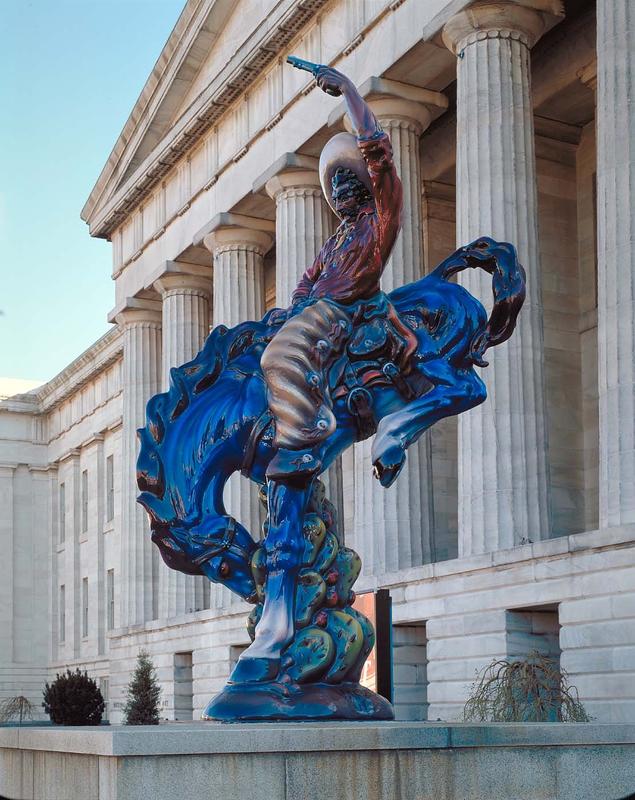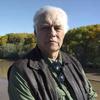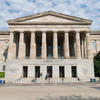More about Vaquero

Sr. Contributor
Luis Jimenez’s colorful sculpture, Vaquero, is quite the contrast with the conservative and traditional columns and architecture of the Smithsonian American Art Museum, where it now stands.
Jimenez is known for the bright, flashy colors he uses in his sculptures made of fiberglass; some might even call his work gaudy, but either way, it certainly grabs people’s attention. Traditional sculptures are commonly cast using bronze or other metals; some are carved from stone, but not many artists use fiberglass as their primary material, especially for public art that is meant to be outdoors, in the elements.
As with some other sculptures by Luis Jimenez, Vaquero (“cowboy” in Spanish) had its share of controversy; there were those who not only thought it was too flashy, but was an undignified, negative, and even violent stereotype of the Mexican cowboy: going wild while firing his gun into the air. This couldn’t be further from the truth; he explained that it was intended as a celebration of the “original” cowboy in the western United States, and not necessarily the stereotypical movie cowboy that we are used to seeing. The statue, at sixteen and a half feet tall, is hard to miss, as it stands next to the steps leading to the east entrance of the museum.
Vaquero was Jimenez’s first public art commission, and was to have a series of five castings, each painted a little bit differently. The first statue was commissioned by the city of Houston in 1980 to be installed next to their City Hall. However, there were objections to the sculpture, and the piece would later be moved to a more “Hispanic” area of town. The version in Washington D.C. did not suffer that same fate; it was cast and purchased in 1990, then installed in the same place where it stands today.
Equestrian statues have a long history, from Marcus Aurelius, (circa 175 CE), in the Capitoline Museums in Rome, to George Washington (1856), located in New York City’s Union Square, and everywhere in between. Hell, even North Korea’s Kim Il-sung and his son Kim Jong-il have matching statues In Pyongyang; the twist there is that vehicles are required to slow down to three miles per hour as they pass by the statues, because that’s how North Korea rolls. Not to be outdone, another dictator, President Gurbanguly Berdymukhamedov of Turkmenistan, had a statue of himself riding a golden horse on top of a mountain of white marble installed in the capitol city of Ashgabat.
Most statues like this are meant to glorify a war hero or commander that led his people to a great victory, while some are meant to represent an idea, such as that of the independent cowboy of the American West, which is both real and imagined. Something the equestrian sculptures often have in common is the rider usually has a weapon, whether a sword, a rifle, or a pistol. Strangely enough, the latter two men mentioned above are not carrying any weapons, probably because they believe that their people love them.
It really is a bold statement that the Smithsonian chose to have this sculpture be the first work of art that visitors see as they arrive at the museum; the Smithsonian Institution Task Force on Latino Issues even said it had “become the symbol of the Museum.” Luis Jimenez’s Vaquero may not be as in-your-face with any type of social message as some of his other works, such as Border Crossing, at Houston’s Museum of Fine Arts, but it does represent a different, perhaps even a more accurate, view of the cowboy in the American West.
Sources
- Allen, Felix. “North Korean Tyrant Orders Motorists to Slow to 3mph When Passing Giant Statues of His Father and Grandad.” The Sun. The Sun, September 25, 2016. https://www.thesun.co.uk/news/1844790/north-korean-tyrant-orders-motori…
- “Equestrian Statue.” Equestrian Statue: Characteristics, History of Equine Sculptures. http://www.visual-arts-cork.com/sculpture/equestrian-statue.htm.
- Faires, Robert. “Larger Than Life.” The late Luis Jiménez created art on a grand scale and lived his life that way, too - Arts - The Austin Chronicle. https://www.austinchronicle.com/arts/2007-03-30/460770/.
- MacMillan, Kyle. “A Mile High and Ever Deeper: Denver’s Burgeoning Public Art Scene.” Public Art Review 20, no. 1 (Fall/Winter 2008): 58–61.
- Manthorne, Katherine. "Luis Jiménez's Vaquero and the Trojan Horse." American Art 20, no. 2 (2006): 28-31. Accessed March 26, 2020. doi:10.1086/507498.
- Ramos, E. Carmen. "The Latino Presence in American Art." American Art 26, no. 2 (2012): 7-13. doi:10.1086/667945.
- “True Colors.” El Palacio. Accessed April 1, 2020. http://www.elpalacio.org/2015/06/true-colors/.
- Schilz, Candice. "Mustangs, Wigwams, and Odes to Chiefs: Artists Share Their Worlds." Art Education 59, no. 1 (2006): 25-32 www.jstor.org/stable/27696121.











